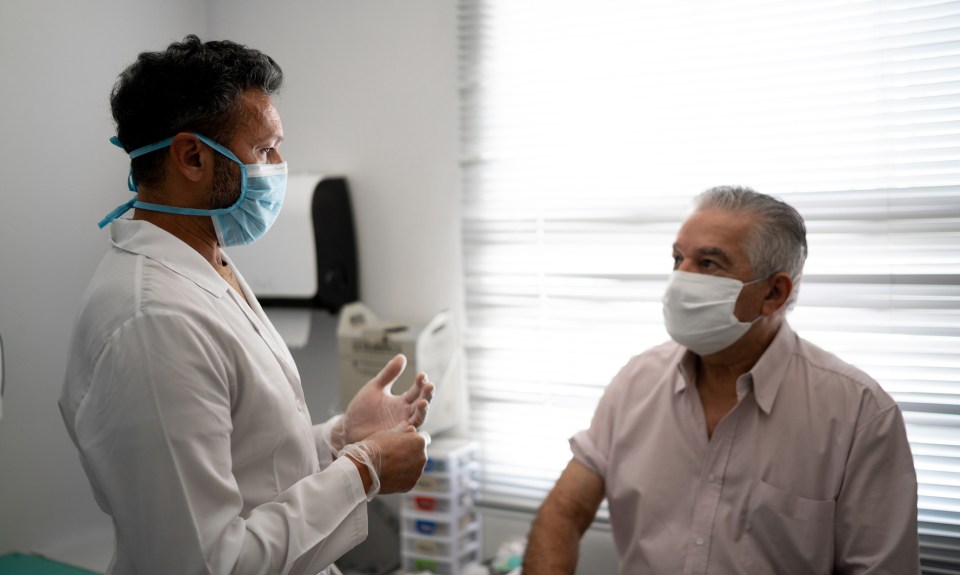One of the best ways for you to protect your health as you age is through health screenings. Identifying health problems in the earliest stages allows for prompt treatment and offers the best chance for a positive outcome. While some health screenings are suggested for both sexes, others are specific to men or women.
It is no secret that your body changes as you age. Physiological changes such as hormonal levels, cell function and loss of bone density all increase health risks. But diet, lifestyle and activity level also play a role. Prioritizing health in your later decades is one way to stay on top of changes and get the jump on issues that can turn serious if ignored.
Health Screenings in Your 50s
By the fifth decade of life, you already know the value of good nutrition, lots of activity and a healthy lifestyle. This is the time to take inventory of your health and the steps you need to take to live a long, enjoyable life.
Women in Your 50s
Mammogram
Designed to detect breast tumors at an early stage, mammograms can identify breast cancer before signs or symptoms appear. According to the U.S. Preventive Services Task Force (USPSTF), women at average risk for breast cancer should begin mammogram screening every two years starting at age 50, if not before. Some women begin mammogram screening as early as age 40, but this is a decision best made by you and your physician. If you have a family history of breast cancer—meaning a parent, sibling or child has been diagnosed with breast cancer—you likely began this screening test in your 40s.
Pap Smear Alone or with HPV Screening
Although guidelines have changed in recent years, the American College of Obstetricians and Gynecologists (ACOG) currently recommends women in their 50s who have not undergone surgical removal of the cervix undergo each of the following screenings:
- HPV test every five years
- HPV/pap smear together every five years
- Pap smear without HPV test every three years
A pap smear is done to detect precancerous or cancerous cervical cells. Almost all cervical cancers are caused by high-risk types of human papillomavirus (HPV). Early detection of abnormal cells allows your doctor to remove any suspicious lesions that could lead to cervical cancer or to treat cervical cancer at an early stage.
Men in Your 50s
Prostate Cancer Screening
Starting at age 50, the American Cancer Society recommends prostate cancer screening for men of average risk who are expected to live at least 10 more years. If found in the early stages, treatment for prostate cancer is more effective, as steps can be taken to stop prostate cancer before it spreads.
Prostate screening consists of the following:
- Testing for a prostate-specific antigen (PSA) found in the prostate and blood. There are a number of factors that cause PSA to rise, including age, prostate enlargement, prostate infection, and some medications. Most men with a PSA blood level below 4 ng/mL do not have prostate cancer, although the American Cancer Society has advised that about 15% of men with a PSA level below 4 actually have cancer that is only revealed after a prostate biopsy. PSA levels between 4 and 10 have a 1 in 4 chance of having prostate cancer. When the PSA level is above 10, there is a 50% chance of prostate cancer. If your PSA levels are above 2.5 ng/mL after your first test, yearly follow-up testing is recommended.
Digital Rectal Examination (DRE)
Some doctors also perform a DRE as part of your prostate screening examination. This is done using a lubricated, gloved finger which is inserted into the rectum to identify any lumps or findings that could indicate prostate cancer.
Women & Men in Your 50s
Some health screenings are appropriate for both men and women in the fifth decade of life. These include the following:
Skin cancer screening – According to information from the American Cancer Society, women are at higher risk of melanoma (the most serious form of skin cancer) before age 50; after 50, melanoma risk is higher in men. Most professional organizations, including the American Cancer Society, The American College of Physicians, American College of Preventive Medicine, The American Academy of Family Physicians and The American Academy of Dermatology, do not currently have specific recommendations concerning the frequency of a skin check performed by a medical professional if you are considered at average risk for skin cancer. However, those groups do encourage examining your own skin for new growths or abnormalities. Since certain factors such as having fair skin, lots of moles, or a comprised immune system increase the risk of getting melanoma, it is a good idea to discuss skin screening with your doctor to determine your specific needs.
Colorectal cancer – Most professional groups recommend colorectal cancer screenings starting at age 45. By your 50s, you should be getting routine screenings for colon and rectum cancer. There are many test options, and screening frequency is determined by the type of test you have. Discuss the various testing options below with your physician to choose the one right for you:
- Stool fecal occult blood – yearly
- Stool fecal immunochemical test – yearly
- Stool DNA test – every three years
- Colonoscopy – every 10 years
- CT (virtual) colonoscopy – every five years
- Flexible sigmoidoscopy – every five years
Hepatitis C – The American Association for the Study of Liver Diseases recommends all adults receive a one-time screening for hepatitis C virus (HCV). The liver virus is nicknamed “the silent killer” because infection from the HCV virus can lead to deadly diseases such as cirrhosis or liver cancer. By the time symptoms appear, liver disease is typically advanced. You are at risk for Hep C if you have used IV drugs, have HIV infection, have received blood or blood product transfusions, are an organ recipient, are a healthcare worker (who may have experienced needle sticks or come into contact with contaminated body fluids) or if you were born to a mother with HCV.
Heart health screening – Testing for coronary artery disease involves multiple different types of screening tests. Beginning in your 20s, the American Heart Association suggests blood pressure screening should be done every one to two years. As you age or your health changes, the frequency of testing should increase and become more inclusive.
- Cholesterol screening – Cholesterol is produced by the body to help digest fat and manufacture hormones. Too much cholesterol causes a plaque build-up in the arteries, increasing the risk of heart disease and stroke. Any adult over the age of 20 should have a cholesterol test every five years. If you are at risk for cardiovascular disease, more frequent testing may be needed, as determined by your physician.
- Weight and body mass index (BMI) – During routine check-ups, your doctor will likely weigh you and determine your BMI. Being obese (BMI over 25) increases the risk of heart disease.
- Blood glucose test – By age 45 to 50, even if you maintain a healthy weight, eat nutritiously, exercise regularly and your blood pressure and cholesterol are within the normal range, you should still undergo blood sugar testing every three years. Blood sugar in the 100-125 mg/dl range indicates prediabetes, while blood sugar of 126 or over is indicative of Type 2 diabetes. If you have prediabetes, you should undergo blood sugar screening every one to two years. Your doctor may recommend one of three tests:
- Fasting plasma glucose test – a blood test done after eight hours of no food or drink (except water).
- A1C – a blood test that measures blood sugar control for the past two to three months.
- Oral glucose tolerance test – a test to determine how your body reacts to a normal amount of glucose, or sugar. An A1C of 6.5% or more indicates diabetes.
Health Screenings in Your 60s
As you enter your sixth decade, making time for these important health checks can be lifesaving. Many of the screenings you had in your 50s carry into the next 10 years.
Women in Your 60s
- Mammograms – Women should continue regular mammograms every two years, as in the previous decade.
- Pap smear/HPV testing – Until age 65, pap smears should be done every three to five years, following the same guidelines as in your 50s. Starting at age 65, the USPSTF no longer recommends pap smear screenings in women who have had routine pap smears in the past and are at no increased risk for cervical cancer.
- Bone density screening – Starting at age 65, the USPSTF recommends routine bone scanning for women. Estrogen plays an important role in maintaining bone mass. After menopause, estrogen levels drop sharply, and bone mass loss increases. Throughout the first decades of life, bone tissue is naturally regenerated. Old bone tissue is broken down in the body and replaced by new. Bone mass stops increasing around age 30. Over the next decades, bone loss outpaces bone growth, making bones more fragile and prone to injury. By the time you reach your 60s, if you haven’t had a bone density screening, now is a good time to start. The most common test to check for signs of low bone mass or osteoporosis, is a dual-energy X-ray absorptiometry (DEXA) scan. However, according to American Bone Health, if your DEXA scan shows a T-score of -1.0 or higher, testing is needed only every 15 years unless you are at high risk of osteoporosis. Some risk factors for osteoporosis include low body weight, long-term low-calorie intake, previous fractures, family history of osteoporosis, dementia, alcoholism, history of falls and lack of physical activity.
Men in Your 60s
- Prostate cancer screening – Men should continue prostate cancer screenings following the same protocol as in the previous decade. Yearly testing is suggested if PSA levels are above 2.
- Aneurysm screening – Abdominal aortic aneurysm (AAA) is a concern for men who smoke or who have smoked in the past. Between the ages of 65 to 75, the USPSTF recommends a one-time ultrasound screening. Since male smokers are in the highest risk group, the test is not routinely recommended for other groups. An aortic abdominal aneurysm is caused by a weakening in the main artery (aorta) that moves blood from the heart to the lower body. A bulge develops at the weak spot in the blood vessel and can rupture without warning, leading to life-threatening complications.
Screenings for Women and Men in Your 60s
Self-skin screenings – Women and men should continue self-skin examinations, watching for new or unusual growths. Areas of concern should be examined by a healthcare professional.
Colorectal cancer screenings – Using the same guidelines as in your 50s, colorectal cancer screenings should continue through stool tests, colonoscopy or sigmoidoscopy.
Heart health screenings – It is important that heart screenings continue as in the previous decade. Changes in physical health could dictate the type and frequency of screenings. In healthy adults in their 60s, blood pressure checks should be done every three years, cholesterol screenings every five years and weight checked at your annual examination.
Health Screening Recommendations for Your 70s
Surprisingly, some routine health screenings you committed to in past decades are no longer recommended after age 70. It is important to understand, however, that general screening recommendations are based on the benefit they provide to the entire population. They are simply guidelines and do not take into consideration your personal health or physical status. For this reason, in your 70s, it is more important than ever to establish a relationship with your health provider and discuss which options are right for you.
Women’s Health Screenings in Your 70s
- Mammograms – Routine mammograms should continue until age 75. After this point, there is no longer sufficient evidence that the screening test is beneficial to most women. Your overall health and specific needs should determine whether routine mammograms are right for you.
- Pap smears – The USPSTF guidelines do not recommend this screening test for women over 65. As with most screening test guidelines, any concerns you have should be addressed by a healthcare professional.
- Bone density screening – Since bone health is extremely important in your 70s, you should continue bone density screening. For women who are taking medications for osteoporosis, the National Osteoporosis Foundation recommends a screening scan be done every one to two years.
Men’s Health Screenings in Your 70s
- Prostate cancer screenings – Most healthcare organizations do not recommend prostate cancer screening past age 70 if you are symptom-free with a life-expectancy of less than 10 years. If you are over 70, your overall health will play an important role in your physician’s determination of whether or not prostate screening is necessary.
- Osteoporosis screening – The American College of Physicians recognizes the risk of osteoporosis that can lead to bone fracture in elderly men as well as women. While women lose bone mass quickly in the first few years after menopause, bone loss in men continues at a much slower pace. By age 65 to 70, the rate of bone mass loss is actually about the same in men and women. Men 70 and over who are considered at risk of osteoporosis may benefit from osteoporosis screening. Risk factors include low activity level, low body weight, low calcium or vitamin D levels, current smoker and those who drink three or more alcoholic drinks a day.
Health Screenings for Women, Men in Your 70s
- Colorectal screening – Until age 75, the USPSTF continues to recommend colon and rectal cancer screening for women and men. Stool testing every one to three years, sigmoidoscopy every five years, and colonoscopy every 10 years remain the best tools for detecting colon cancer. Testing for colorectal cancer is not recommended for men or women after age 75, but if you are in good health with a life expectancy over 10 years, your physician may opt to continue screening tests.
- Heart health screening – Blood pressure, cholesterol, blood sugar and body weight continue to require monitoring. Although the USPSTF doesn’t provide guidance on optimal screening intervals, screening frequency will likely be based on your overall health and whether you fall within the normal range for these tests.
- Depression screening – Although many look forward to their golden years and imagine them to be carefree and relaxing, some elderly adults suffer from depression and unhappiness. Everyone gets the blues occasionally or experiences sadness at the loss of friends and loved ones, but true clinical depression is a medical condition that requires diagnosis and treatment. Older adults are at increased risk of depression and are frequently misdiagnosed or undertreated. Depression is more common in older adults with one or more illnesses, such as heart disease or cancer. According to statistics from Mental Health America, the second highest suicide rate in the country occurs in those 85 and older. If you notice changes in yourself or a loved one, seek help from your medical provider right away. Depression can be identified and treated using methods such as the Geriatric Depression Scale.
The content of this site is for informational purposes only and should not be taken as professional medical advice. Always seek the advice of your physician or other qualified healthcare provider with any questions you may have regarding any medical conditions or treatments.



